Breadcrumb
- Our Work
- Sharing the Shore: Safely Viewing Marine Mammals in California
Sharing the Shore: Safely Viewing Marine Mammals in California
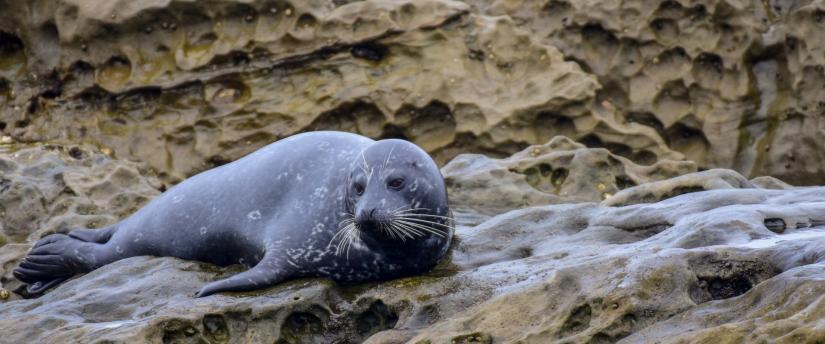
Here in California, we have ample opportunities to see many of the marine mammals with whom we share our beautiful coast. While leaping dolphins and barking sea lions can be fun and interesting to observe, it’s important to know how to go about interacting properly so that neither humans nor animals get harmed in the process. Plus, all marine mammals are protected by federal law under the Marine Mammal Protection Act (MMPA), and any interactions that disturb or harass the animals could result in fines or jail time.
To help you get the most from your wildlife viewing experience, while still maintaining a safe and healthy environment for all, review these tips for safe (and legal) viewing of marine mammals:
What marine mammals do we have here in California?
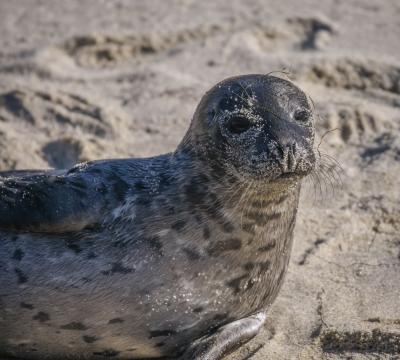
We have a broad range of wildlife on the California coast, including many species of dolphins and whales. California sea lions, harbor seals and elephant seals, sea otters and fur seals are among the animals you are likely to see on the beaches, as they haul out to sun themselves and rest.
Why shouldn’t you interact with these animals?
Unlike the happy-go-lucky sea lions we are used to seeing in movies, theme parks, and internet memes, the ones you are likely to encounter on our beaches are wild animals. They may carry a range of diseases and bacteria which can result in serious infections, and are likely to bite or respond negatively to human interaction when provoked.
Close interactions can prove harmful to the animals as well, inducing stress that may weaken their immune systems, or frightening them into abandoning pups or falling off rocks. While your brief interaction with an animal might seem harmless—perhaps it was only a few seconds long—these interactions can add up to severe disturbances for the animals when they are multiplied across hundreds or thousands of potential human interactions every day.
How far away should I stay from any marine mammals?
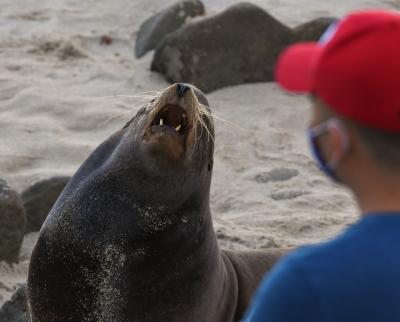
Always maintain an appropriate distance. While the MMPA does not specify strict requirements on distances for viewing seals and sea lions, the National Oceanic and Atmospheric Administration (NOAA) recommends keeping yourself and pets at least 100 yards (the length of a football field) from seals and sea lions. However, it is more important to pay attention to the animals' behavior—you’ll know you’re too close if an animal starts to stare, fidget, vocalize at you, or flee into the water. Even from a distance, animals may become disturbed if they are downwind from you and/or your pets, so it’s important to look out for agitated behavior to minimize any possible impact you may have.
What precautions should I take when walking my dog on the beach?
Always keep your pets on leashes around any wild animals. While your dog may only seem to be playing or curious, these disturbances can be quite stressful for marine mammals that aren’t used to seeing dogs. Off-leash pets can potentially harm or kill wildlife, which can be particularly devastating for threatened species. Similarly, pets risk being injured or contracting an illness from wild animals.
Why shouldn’t I feed the animals?
Never attempt to feed wild animals. Not only does this put you in harm’s way with potentially hungry wild animals, it is often dangerous for animals to associate humans with food. This can become a problem where people commonly fish, as large sea lions may decide to come into close contact with humans on boats and docks.
How close can I get to take pictures of the animals?
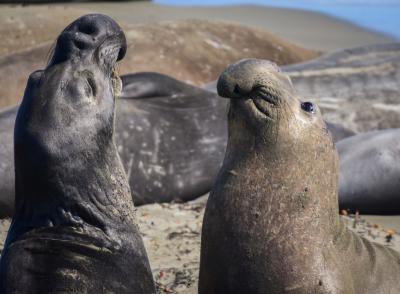
The same distance guidelines as above still apply. Don’t attempt to take selfies with wild animals or pose near them for pictures. Not only is this unsafe, it is also illegal. If you want to get close-up pictures of wildlife, it is a better idea to invest in a camera with a telephoto lens than to try and approach too closely. This will allow you to observe the wildlife from a safe distance, and it also gives you the chance to observe their natural behavior, undisturbed by human intrusions.
What should I do if I see an animal that looks sick or injured?
Just like humans, seals and sea lions can get sick, injured, and occasionally fall on hard times. Sometimes they contract illnesses or infections, which may also prevent them from hunting and could result in stranding and starvation. Young seals and sea lions, in particular, may strand as they begin learning to hunt and feed themselves for the first time. They may also fall victim to shark bites or break bones falling off of rocks.
Don’t attempt to intervene on your own. Sick and injured animals can behave unpredictably, and may react violently if they feel threatened. Getting too close to the animal also risks scaring it away, which will only make it more difficult for professional rescuers to provide needed care. The entire West Coast is covered by a Marine Mammal Stranding Network that can be called to respond for marine mammals in distress. These teams are trained and permitted to handle wildlife safely, and have the appropriate equipment and protective gear to ensure their own safety and that no further harm is done to the animals.
To report a stranded marine mammal on the West Cost, you can call the West Coast Stranding Hotline, 1-866-767-6114, or contact your local Stranding Network organization.
What if I see a baby seal or sea lion (also known as a pup) that has been left by its mother?
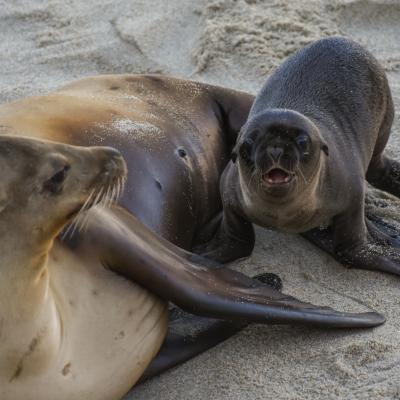
If you see a pup that looks abandoned or in distress, don’t attempt to intervene. Mother seals and sea lions will often leave their young for 24 to 48 hours while they hunt for food in the ocean. If, upon returning, they see humans too close to the pup, the mother may not return and could abandon the pup.
Abandoned pups are rarely able to survive without professional intervention. These animals often need to be euthanized or kept in captivity for the rest of their lives, as they are not generally able to thrive in the wild after being hand-raised by humans.
If you suspect that a pup has been abandoned, please contact your local Stranding Network organization. Often these animals will be kept under a period of surveillance, to determine if the mother returns or a rescue is needed.
What should I do if a seal or sea lion comes up to me?
Even if approached by an animal, it remains your responsibility to back away and give the animal its appropriate distance. Some of the seals and sea lions on our coast have been rescued and rehabilitated before, and may be more comfortable with humans than others. However, this does not make them tame or safe to be around. They are still wild animals, can still bite and carry diseases, and are still protected under the law. Even “positive” interactions are a disturbance in the animal’s natural behavior, and are still illegal under the MMPA.
What about when in the water? (Swimming, surfing, kayaking, etc)
While swimming or snorkeling, particularly in areas where seals and sea lions are known to frequent, there is a good chance you could be approached by one of these animals in the water. They can often be quite curious, and are more likely to investigate you while in the water where they can comfortably get away.
Do not attempt to touch or chase an animal that decides to get close to you. Watch its behavior and allow the animal to dictate the interaction. If behavior is aggressive or threatening, it is important to calmly move away. Pay attention to areas where there are animals resting or young present, as adults may be more protective if you intrude.
For more information and resources, check out the NOAA Share the Shore website.
Written by California Sea Grant Science Communication Fellow Nicholas DeNezzo.
Reviewed by NOAA California Assistant Stranding Coordinator Justin Greenman.
- California Seafood Profiles
- Aquaculture in California
- Discover California Commercial Fisheries
- Seaweed Aquaculture
- Kelp
- Coastal Hazards & Resilience
- Marine Protected Areas
- Red Tides in California
- King Tides
- Rip current safety
- FAQ: California’s Marine Heatwaves
- FAQ: Droughts & California’s Coastal Regions
- Estuaries: Connecting Land to Ocean
- Street Trash Monitoring Protocols and Educational Curriculum
- Safely Viewing Marine Mammals
- Grunion: bridging land and sea
- Delta Smelt
- Recursos en Español